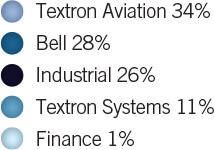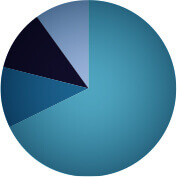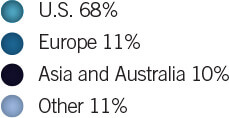2020 was a challenging year for our company as we worked through the impacts of the COVID-19 pandemic. Our operations have experienced and continue to experience various degrees of disruption due to the unprecedented conditions surrounding the pandemic. Across our businesses, we established enterprise-wide pandemic response teams and implemented processes and procedures to enhance the safety of our facilities and protect the health and safety of our employees.
At our defense businesses, through the hard work of our teams, we were able to maintain our operations, meet our customer commitments and deliver strong results. At our commercial businesses, we temporarily closed some of our manufacturing facilities due to reduced demand for certain products during the first quarter and latter part of the second quarter. In the second half of the year, our commercial businesses have generally experienced an increase in customer demand compared with the first half of 2020. Building on this momentum, we delivered strong fourth quarter results and look to carry this into 2021.
Our revenues for the year were $11.7 billion. We recorded a segment profit of $751 million with a profit margin of 6.4 percent. Through a focus on working capital management and cost control, our manufacturing businesses generated $833 million of net cash from operating activities of continuing operations.
INVESTMENTS LEAD TO NEW OPPORTUNITIES WITH MILITARY CUSTOMERS
Despite the pandemic, our prior investments in our new products and technologies at our defense businesses enabled us to move forward on a number of military programs and win new contract awards in 2020.
Our Future Vertical Lift programs at Bell advanced in 2020. Both the Bell V-280 Valor and Bell 360 Invictus were down-selected by the U.S. Army for the next rounds of the Future Long-Range Assault Aircraft (FLRAA) and Future Attack Reconnaissance Aircraft (FARA) programs, respectively. The down-selects illustrate the outstanding design, innovation and tested technologies that can fulfill the Army’s FLRAA and FARA requirements at an affordable cost and to our customers’ schedules.
By December, the V-280 had flown over 200 hours through more than 150 test flights as part of a rigorous flight test program. Throughout the program, the team has worked closely with the Army to demonstrate the V-280 is a low-risk, affordable and sustainable aircraft that will redefine the battlefield for decades to come. As part of the test program, multiple Army Experimental Test Pilots have flown the V-280 and soldier touchpoint events have enabled pilots, maintainers and infantry soldiers to share their input.
The Army’s down-select of the Invictus followed almost one year of design and risk-reduction work by the Bell team as part of the initial contract phase. Like the V-280, the Invictus design combines innovation with tested technologies to fulfill the customer’s requirements at an affordable cost that meets the Army’s schedule.
In late 2020, the Department of Defense awarded Bell Boeing a contract that includes recurring procurement of kits and installs for nacelle improvements onto the CV-22 aircraft for the Air Force. These modifications to the nacelles will improve maintainability, reduce maintenance man-hours and improve readiness rates.
Bell also reached delivery milestones with its H-1 and V-22 programs. In May, Bell successfully delivered the 150th Bell AH-1Z helicopter and the 100th Zulu Build New manufactured at our Fort Worth and Amarillo facilities. Bell also delivered its 400th V-22—this milestone was a CV-22 aircraft to the U.S. Special Operations Command—as well as the first CMV-22B variant designed specifically for carrier fleet operations for the U.S. Navy. Japan became the first international operator of a V-22 when the U.S. government delivered the tiltrotor to Camp Kisarazu that will be operated by the Japan Ground Self Defense Force.
With its innovative products and technologies and through partnerships with our military customers, Textron Systems won a number of new contracts during the year.
Demonstrating its confidence in Textron Systems’ Ship-to-Shore Connector program, the U.S. Navy awarded a follow-on production contract for additional SSC craft. This brings the current number of SSC craft being produced by Textron Systems to 24. The SSC program marked a significant milestone with the fly-away of the first two SSC craft from Systems’ New Orleans shipyard to the Naval Surface Warfare Center in Florida.
Textron Systems’ ATAC business won four contract awards as part of the U.S. Air Force’s Combat Air Forces (CAF) Contracted Air Support (CAS) program. With these contracts, ATAC will use its fleet of fighter aircraft for adversary air and close air support live training for the Air Force as well as the U.S. Special Operations Command. ATAC also received an award to support the Navy and Marine Corps, under the Fighter Jet Services (FJS) program. ATAC has been steadily building its fleet of Mirage F1, F-21 Kfir and MK-58 Hawker Hunter fighter aircraft to position itself for these strategic wins.
Textron Systems was also awarded a contract to support work on the U.S. Air Force’s Ground Based Strategic Deterrent (GBSD) missile system, under prime contractor Northrop Grumman. The GBSD is intended to serve as a cornerstone of the nation’s nuclear triad and to provide a reliable nuclear deterrent.
Textron Aviation delivered its first Beechcraft AT-6 Wolverine to the Air Force. This multi-mission aircraft is designed to meet a wide-mission spectrum including training, manned Intelligence Surveillance and Reconnaissance (ISR), and light precision attack. As government, military and commercial customers look for airborne solutions for critical missions, Textron Aviation’s special missions and defense business is well positioned to meet their needs.
MOVING FORWARD ON NEW PRODUCT PROGRAMS
In May, Textron Aviation’s Cessna SkyCourier, the new clean-sheet twin-engine, large-utility turboprop aircraft, made its first flight. By the end of the year, there were three test articles in the certification program with more than 400 flight hours completed. The SkyCourier is on track for entry into service in the second half of 2021.
Demonstrating our commitment to refreshing our product lineup, Textron Aviation also brought innovation to its iconic Beechcraft King Air turboprop product line with the introduction of two aircraft: the King Air 360, its updated flagship turboprop, and the King Air 260, which builds on the platform’s rich history of rugged reliability and versatility. Both aircraft offer the latest technological advancements in the cockpit and enhancements to passenger comfort. Textron Aviation began deliveries of the King Air 360 during the fourth quarter, delivering eight units.
Bell completed several key certification activities with the Bell 525 Relentless as it moves closer to becoming the first certified commercial fly-by-wire helicopter in the market. As Bell’s largest commercial product, the Bell 525 features best-in-class design, offers exceptional visibility and superior payload and range capabilities for customers.
For the third consecutive year, a Bell innovation was named one of Popular Science’s Best of What’s New in the Aerospace category. For 2020, Bell’s Electrically Distributed Anti-Torque (EDAT) system was recognized. EDAT is comprised of four small fans electrically powered by four separate motors that replace a conventional tail rotor, enhancing on-the-ground safety and reducing noise pollution, carbon emissions and operating costs.
In addition to EDAT, Textron Systems’ RIPSAW® M5 unmanned ground vehicle was also recognized by Popular Science in the Security category. The RIPSAW M5 features an open architecture, giving the Army a highly configurable and leading unmanned ground system. With variants that include hybrid-electric and all-electric powertrains, the RIPSAW M5 provides the Army with extreme mobility and speed for multiple missions. The M5 delivers full mobility using its powerful electric drivetrain and can extend run-time with a modular range extender in the hybrid-electric variant. This vehicle keeps soldiers safe by providing an unmanned system to undertake the most hazardous and strenuous missions.
As Textron Systems supports the Army with Shadow unmanned aircraft in the latest Block III configuration, the team is leveraging its more than 30 years of unmanned systems experience with the Aerosonde Hybrid Quad (HQ) for the Army’s Future Tactical Unmanned Systems (FTUAS) program. In 2019, the Army selected Textron Systems to participate in Phase 1 of the FTUAS program. Over the past year, Textron Systems has continued flight testing as it competes for this program to protect tomorrow’s warfighters.
TSV focused on new product development, particularly leveraging electric technology and connected-vehicle experiences for its products. Building on the success pioneered in golf by E-Z-GO’s ELiTE series of lithium-powered golf cars, TSV launched a Jacobsen Eclipse 360 ELiTE riding greens mower, a fully electric machine. Powered by an energy-efficient, zero-maintenance battery system, the Eclipse 360 ELiTE performs silently and provides course operators with significant operational savings.
As a recognized leader in hybrid fuel systems solutions, Kautex has a solid understanding of its automotive customers’ current and future requirements. During the year, Kautex won contracts with major OEMs for its fuel systems while continuing its focus on innovation, particularly around the technologies for hybrid fuel systems, electric and hybrid-electric battery systems and sensor cleaning solutions for autonomous driving technologies.
DELIVERING ON CUSTOMER SERVICE AND SUPPORT
As we continued to move forward with our products and technologies, we kept our focus on strengthening our customer service and support. During the year, we acquired Zhenjiang Aerochine Aviation Limited to increase Bell’s helicopter maintenance, repair and overhaul capabilities in China and also opened three Bell Authorized Maintenance Centers in Europe for our rotorcraft customers. Meanwhile, Textron Aviation’s acquisition of Premiair Aviation Maintenance Pty Ltd. in Australia strengthened and expanded support for our Beechcraft, Cessna and Hawker customers.
To ensure we’re building a pipeline of future customers, Textron Aviation continued to partner with leading pilot training programs through its Top Hawk initiative. This initiative provides training programs and universities across the country with a factory-new, custom branded Cessna Skyhawk aircraft for student pilot training and to promote pilot training at air shows, aviation contests and recruiting events. This is an opportunity to introduce the next generation of pilots to our products.
WELL POSITIONED FOR GROWTH
2020 was a challenging year for our employees, personally and professionally. I am proud of the way our teams responded. While we dealt with significant operational disruptions, we continued to support our customers throughout the pandemic and responded to both dramatic reductions and increases to customer demand over the course of the year. Our teams also achieved critical milestones on the programs and product development efforts that are important to our future growth.
As we enter 2021, we take a pragmatic approach to the challenges that may remain but are confident that our teams will deliver for our customers today while continuing to execute on our growth strategies for tomorrow.

Scott C. Donnelly, Chairman and Chief Executive Officer






